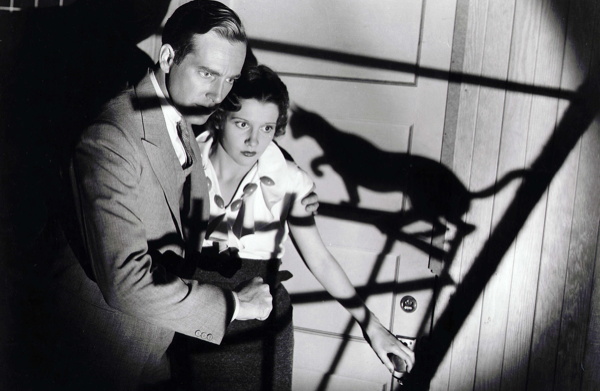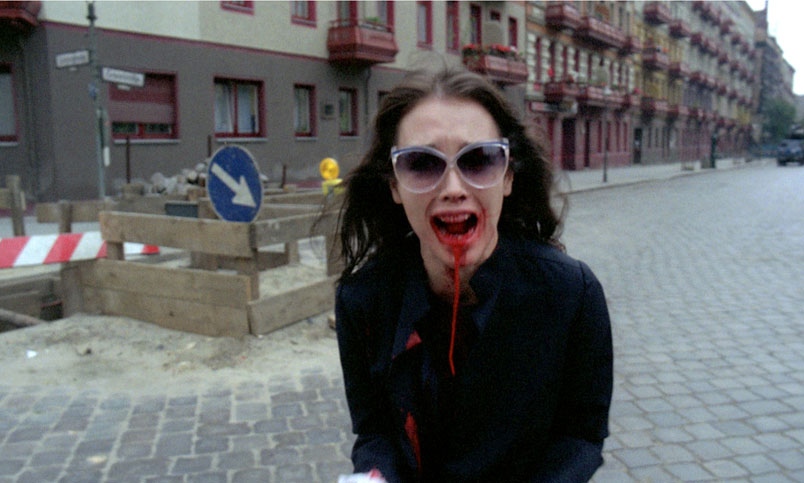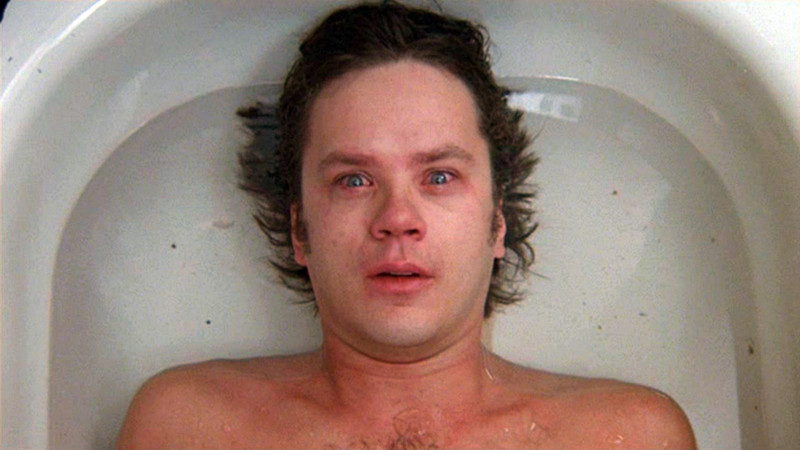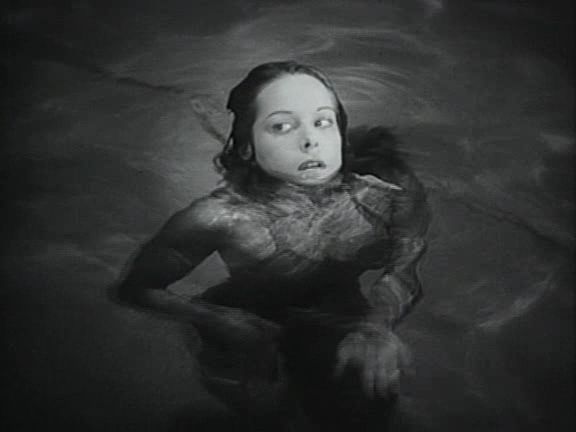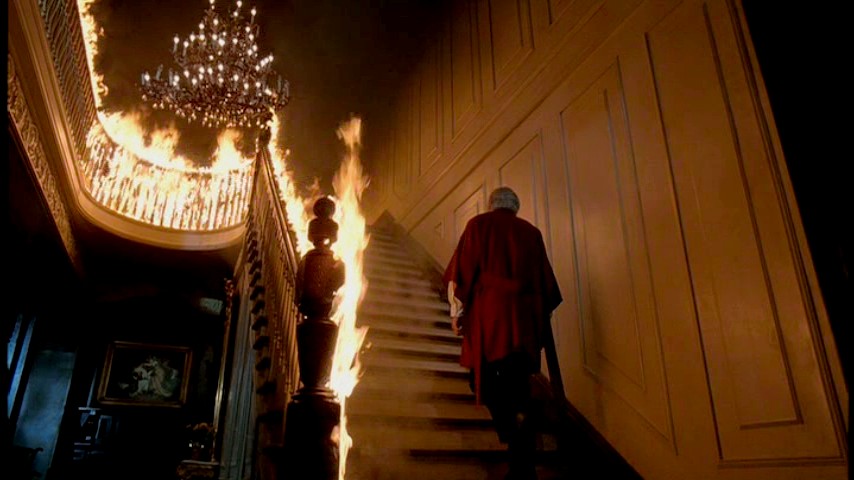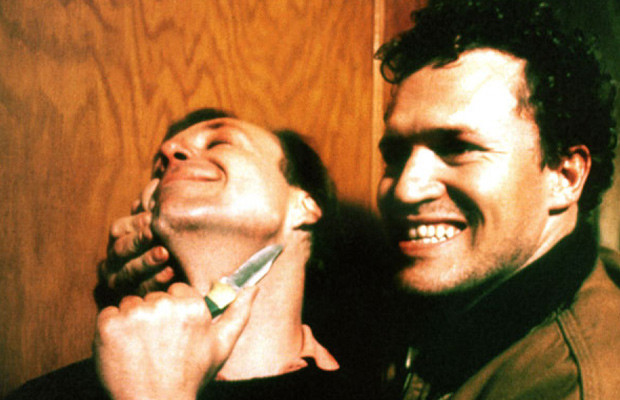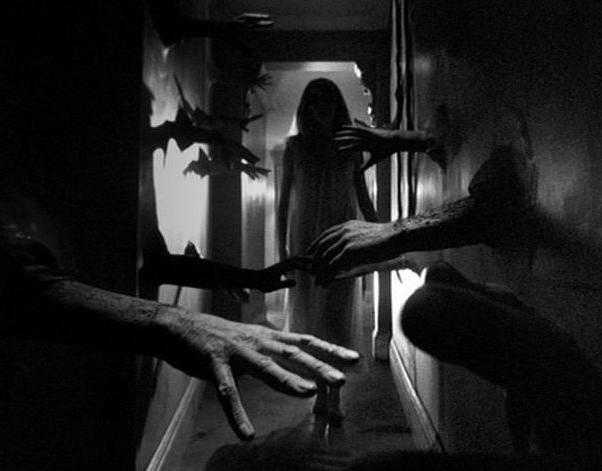16. The Black Cat
Vitus Werdegast arrives at the home of his arch-nemesis Hjalmar Poelzig -whom he blames for the death of his wife and child years before – with vengeance on his mind. Meanwhile, Poelzig has plans of his own…
At little over an hour long it for a moment drags its feet. Murder, revenge, ailurophobia, incest, necrophilia, pedophilia, sacrifice and Satanism are all shown or hinted at. Certain elements are introduced and either never explained or heard of again. The dialogue is risibly laughable, almost at odds with the ghoulish display. This weaving together of these disparate elements adds a certain lunatic charm and provides part of the film’s appeal.
The setting is supplanted from the usual fare of gothic castles to a striking, modernist architectural design without losing any of the overbearing atmospheres of the former. The location itself is a selling point, but the film’s real raison d’être is the scenery-chewing pairing of these two horror stalwarts: mortal enemies, locked in psychological warfare, each seeking no less than the other’s absolute destruction. A camp classic.
17. Possession
Beginning at a fever pitch and escalating from there into utter frenzied insanity Possession is a story of martial breakdown that begins with the acerbic, venom spitting hatred of a Bergman film and descends into the realms of the vile, squelching body horror of Cronenberg.
The performances here are paramount to the films effectiveness, and its leads excel at hitting every deliberately overwrought note required of them, progressively ratcheting up the intensity and employing every shrieking, hysterical affect they can muster.
Adjani in particular deserves special mention; her demented displays of emotion and manic bodily contortion are electrifying.. Her infamous subway scene is something to behold, and absolutely unforgettable.
Viewers will have never seen anything like it. They may not want to again in a hurry.
18. Jacob’s Ladder
Jacob Singer is a man haunted. The death of his young son and the eventual breakdown of his marriage still weight heavy on his heart, and this is compounded by the horror of his memories of Vietnam. Now, his life is becoming a waking nightmare: plagued by bizarre incidents and tormented by baffling visions of disturbing humanoid creatures. Is he losing his mind, or are there more sinister forces at work?
Jacob’s Ladder is a forbidding riddle of a film in which its protagonist’s search for answers takes him seemingly through layers of reality, forever bleeding and blurring into each other, and in which nothing can be trusted. The goings-on and horrific visions seem inextricably linked to his past, as well as his own tortured inner world. Jacob thinks of his tormentors as “demons”. The demons here are both metaphorical and physical.
Rife with hellishly disturbing and indelible imagery, Jacob’s Ladder is a veritable fever dream of pain and anguish, and a must see for fans of the genre.
19. Cat People
Pity poor Irena. So convinced is she of the old legends from her childhood in Serbia that she is unwilling and unable to physically express her love to her new husband for fear that she will turn into one of the fabled “Cat People” and tear him apart.
A textbook example of the “less is more” school of horror filmmaking, Cat People exemplifies better than any other in the stable this philosophy for which producer Val Lewton’s films became known. Two stalking sequences by an unknown pursuant – one on a dimly lit street and another in a darkened pool area – are virtuoso in their suggestive use of shadow and sound, and are still today among the most effective in the genre.
Beneath this masterful use of shadow and insinuation lurks pathos in the tragedy of Irene. The entire film is predicated on the idea that, despite ones best intentions, one is inherently bad and doomed to hurt those they care about. Irene wants only to love and be loved, but she cannot. There is horror in her anguish. Her pain is universal.
20. The Changeling
Ghost stories are a dime a dozen. There is no shortage of disembodied voices, ghostly whispering or things that go bump in the night in the horror genre, and The Changeling has them in spades. It is never derivative however, in fact schooling the myriad of similar films on how it’s done. It is almost inexplicable in its creepiness. Here’s a film that gets under your skin.
After the deaths of his wife and daughter classical composer John Russell moves – as protagonists in these films often do – into a massive old house. It is not long before terrifying noises and other strange occurrences begin to manifest. Perhaps because he is still haunted by his own grief, John bears no scepticism, and is quick to realise whatever spirit resides there is leading him towards the house’s secrets.
The Changeling touches on themes of guilt and loss, of repressed truth and the things that we do not want to believe about ourselves and those we love. The main reason to recommend it, however, is for its style – all wide angles with deep focus, with otherworldly sound design – and for its uncanny ability to frighten. This is a truly chilling film.
21. Devil’s Backbone
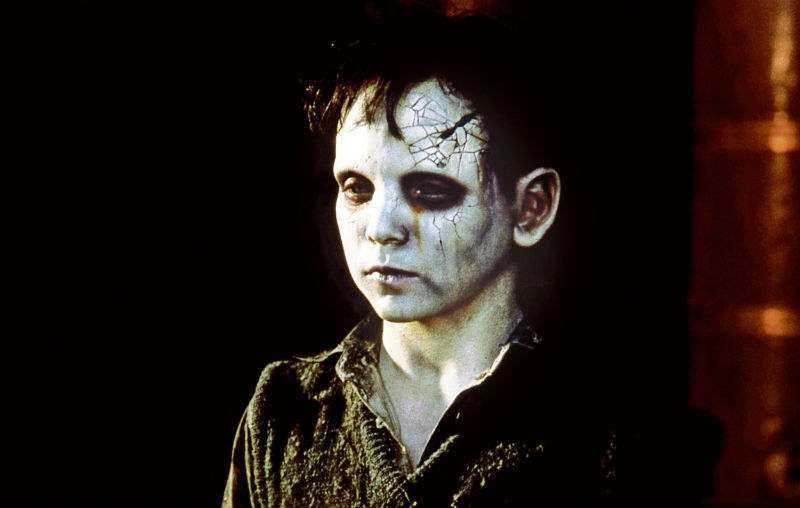
“What is a ghost?” the opening narration asks. “A tragedy condemned to repeat itself? An emotion suspended in time?” The most effective ghost stories know that ghosts are both supernatural and metaphorical. Its characters are haunted as much by themselves as by any spirit. There can be no haunting without someone to be haunted. The Devil’s Backbone understands this more than most.
The film is set during the Spanish Civil War in an evocatively remote orphanage, where young Carlos finds himself in his parent’s absence. There he must adjust to his new home, contend with the animosity of bully Jaime, and steer clear of the sinister Jacinto, who plots to steal gold hidden within the orphanage walls. The other children whisper of “ the one who sighs”, and Carlos himself will eventually come face to face with this spirit, but is it friend or foe?
The Devil’s Backbone is a beautiful and melancholic meditation on sorrow and cruelty. Its historical and brutally realistic setting provides a fitting contrast to the supernatural elements and affords them an added poignancy missing in the usual haunted house fare. There are ghosts in this film, both supernatural and metaphorical. There are ghosts beyond its edges.
22. Henry: Portrait of a Serial Killer
“He seemed like such a nice guy” seems such a common sentiment in reports of serial killers. Henry: Portrait of a Serial Killer is also the portrait of a man, just a man.
Young Becky meets her brother Otto’s housemate Henry, and is drawn to him. He is handsome, charming. She discovers they share something in common: a childhood filled with pain. What they do not share in common is murder.
The film is skilful in the way it initially allows the viewer knowledge of Henry’s nature, whilst separating him from his actions, thus enhancing his “everyman” aspect. Despite the compulsive disconnectedness and fury with which he kills, Henry doesn’t seem completely beyond the capability of empathy. He defends Becky from the advances of her lecherous brother, and later when Otto becomes his accomplice, he appears to maintain a sort of righteous code – albeit a twisted one -and regulates Otto’s behaviour, whose slide from simply amoral to evil happens with too much ease.
Are there degrees of evil? Why does one traumatic childhood create a monster and another does not? The film provides no answers. It wants only to show that monsters are real. They are human. You might know one. Herein lies its effectiveness.
23. Repulsion
There is something off about Carol. Left alone in her apartment when her sister takes a holiday, her mind begins to unravel. Cracks appear within the apartment. Food rots and festers around her, attracting flies. Disembodied hands tear and clutch at her from the walls. And at night, she has nightmares of rape.
Repulsion takes us into the headspace of its protagonist. She begins the film an odd character – dazed, aloof, petulant, almost childlike – and ends it completely unhinged. The film is her waking nightmare, and the viewer experiences it right there along with her. It is clear she is motivated by some horrendous internal logic the viewer withheld from the viewer until the films final moments.
Director Roman Polanski keeps the visual interest and creativity high throughout, and Catherine Deneuve is invaluable as the tormented Carol. Together, they have crafted something as twisted as it is memorable.
